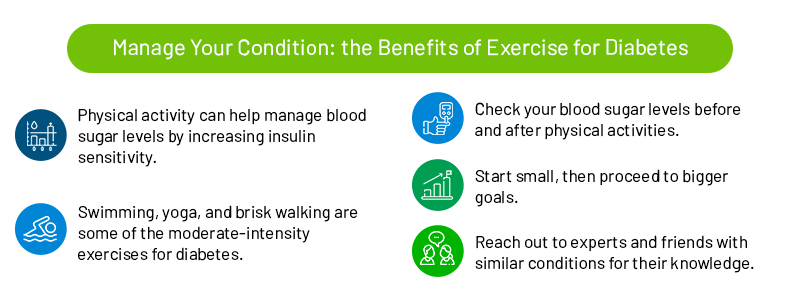There are a lot of benefits of exercise for diabetes, including that it can help regulate your blood sugar levels and reduce your risk of complications.
Physical activities play a significant role in maintaining overall body fitness and reduces your risk of chronic diseases like diabetes, cancer, depression, and anxiety. Swimming, yoga, weight training, and similar low-impact exercises are excellent exercises for diabetes control.
This guide will dig into everything you need to know about exercise for diabetes, including the benefits, easy exercises to add to your daily routine, and how to get started.

Benefits of exercise for diabetes
People who have been diagnosed with diabetes know to check their blood sugar levels, properly use their medications, and check in regularly with their health care providers. However, there are other interventions to help manage and mitigate the negative impacts of their conditions. Physical activity can play an important role in managing blood glucose levels and lowering the risk of heart conditions and nerve damage.
Here are a few benefits of exercise for diabetes :
- An active body increases insulin sensitivity.
- It also allows the body’s cells to efficiently use blood sugar for energy production.
- Physical activities help lower blood pressure and decrease the threat of diabetic complications.
- Exercise lowers cholesterol levels and protects an individual from certain heart diseases.
- It can help with weight loss and keeping body weight within a healthy range.
- Exercise can help people with prediabetes or type 2 diabetes achieve remission.
- Physical exercise paired with healthy eating and food habits can bring significant changes in the well-being of a person and can be an important tool in diabetes care. That makes knowing where and how to get started all the more important.
Things to check before the exercise
Diabetes and exercise have unique challenges. You must monitor your blood sugar levels before and after physical activity, for example, to ensure your health and safety. No extra precautions are required before exercise if you are not on medications, but it’s always good to check in with your primary care provider before you begin a new workout regimen.
Here are some quick facts about exercise for diabetes:
- If your sugar is lower than 100 mg/dL, it is too low for physical activity.
- Before getting started, consume a snack with 15-30 grams of carbohydrates like fruits, fruit juice, or even glucose tablets.
- A sugar level ranging between 100-250 mg/dL is safe enough for a workout session.
- A sugar level above 250 mg/dL is risky for exercise.
- Test your ketones. Ketones form when the body breaks down fat, and a high number of them indicate a lack of insulin in the body.
- High levels of ketones can cause ketoacidosis, a severe diabetic complication requiring emergency treatment.
A total of 150 minutes per week of moderate-intensity exercise is required for good health benefits. If you have been relatively inactive for a while, getting a green light from your doctor is important. They will be in the best position to suggest durations, activities, and assess any impact your lifestyle changes will have on your medications and diabetes management.
How to get started with exercise for diabetes
Starting on an inactive body can be demanding. First, jot down the activities you enjoy. Choosing a type of exercise you want or like to do will be easier than immediately jumping into something you hate. Then, go slow. Start with walking 10 minutes a day and gradually increase the duration.
Here are a few other tips:
- Get a workout buddy– Having an exercise partner for accountability and comradery can bring a lot of positivity and motivation.
- Have a goal – Start small, but have a target in mind. You might begin by working out for 10 minutes per day, but set a goal of eventually being able to work out for 150 minutes a week.
- Schedule your workouts – Discipline is key to exercise for diabetes and overall health. Planning when you will exercise will help you develop a habit of working out in a concise period.
Experimenting with something new can be stressful. You might feel anxious about how your body will cope with new physical activities, but you don’t have to go it alone. Get in touch with the experts to learn the dos and don’ts for a confident start. Connect with people experiencing similar situations to share tips and stories. You’ll be on your way to better health in no time through exercise for diabetes.
5 easy exercises for diabetes
If you’re not sure where to start when kicking off a new workout regimen, there are a few workout options that are good for all ability levels. Here are some lower-impact workouts for all ages and abilities:
- Swimming –Swimming is an aerobic exercise and is ideal for people with type 2 diabetes. Water takes pressure off your joints, which can help you exercise without pain. You can also wear water shoes while swimming to avoid foot complications .
- Yoga –Did you know that your blood sugar rises with your stress levels? Yoga helps by creating mental peace, reducing depressive symptoms, improving heart health, and relaxing your body. This also helps to minimize stress-related impacts on your blood sugar levels.
- Bicycling –Bicycling is another mode of low-impact aerobic exercise that aims to keep your heart strong and help you burn excess calories. Ride just a few times a week to see positive impacts.
- Brisk walking –This moderate-intensity workout helps regulate your heart rate. Grab a pair of walking shoes and get started with a 10-minute walk. Work up to 30 minutes per day for better results.
- Strength training –Losing muscle mass can make it difficult to maintain stable blood sugar levels. Resistance training builds muscle mass and is highly recommended for people with type 2 diabetes. You can use free weights or bands to add light resistance, working up to heavier or tighter options as your strength improves.
It’s important to consult your physician before beginning any exercise program, but these activities are a great place to start your fitness journey. Stick with it, and you’ll likely be seeing the benefits of including regular exercise in your diabetes management plan.
Things to check after the exercise
Checking your blood sugar levels after exercise is as vital as doing so before your workout. Keep an eye on them for a few hours after you’re done, too. This is because the reserved sugar stored in your muscles and liver gets exhausted during exercise, and the process of rebuilding your muscles also draws sugar from the blood.
Note: The more strenuous the activity, the more impact it will have on your blood sugar. If you’re planning intense exercise, be sure to grab a small snack containing carbs to prevent issues with hypoglycemia (lower blood sugar).
Are you ready to change your life? At CrossFit Alanis, Head Coach Beaux Dyson is also a Master Level Nutritionist and BC Hol. Health Practitioner with a long history of addressing and reversing Diabetes and Heart Disease THROUGH SUSTAINABLE FITNESS AND NUTRITION . A consultation is free and could change the course of the rest of your life. RESERVE YOUR CONSULTATION HERE




